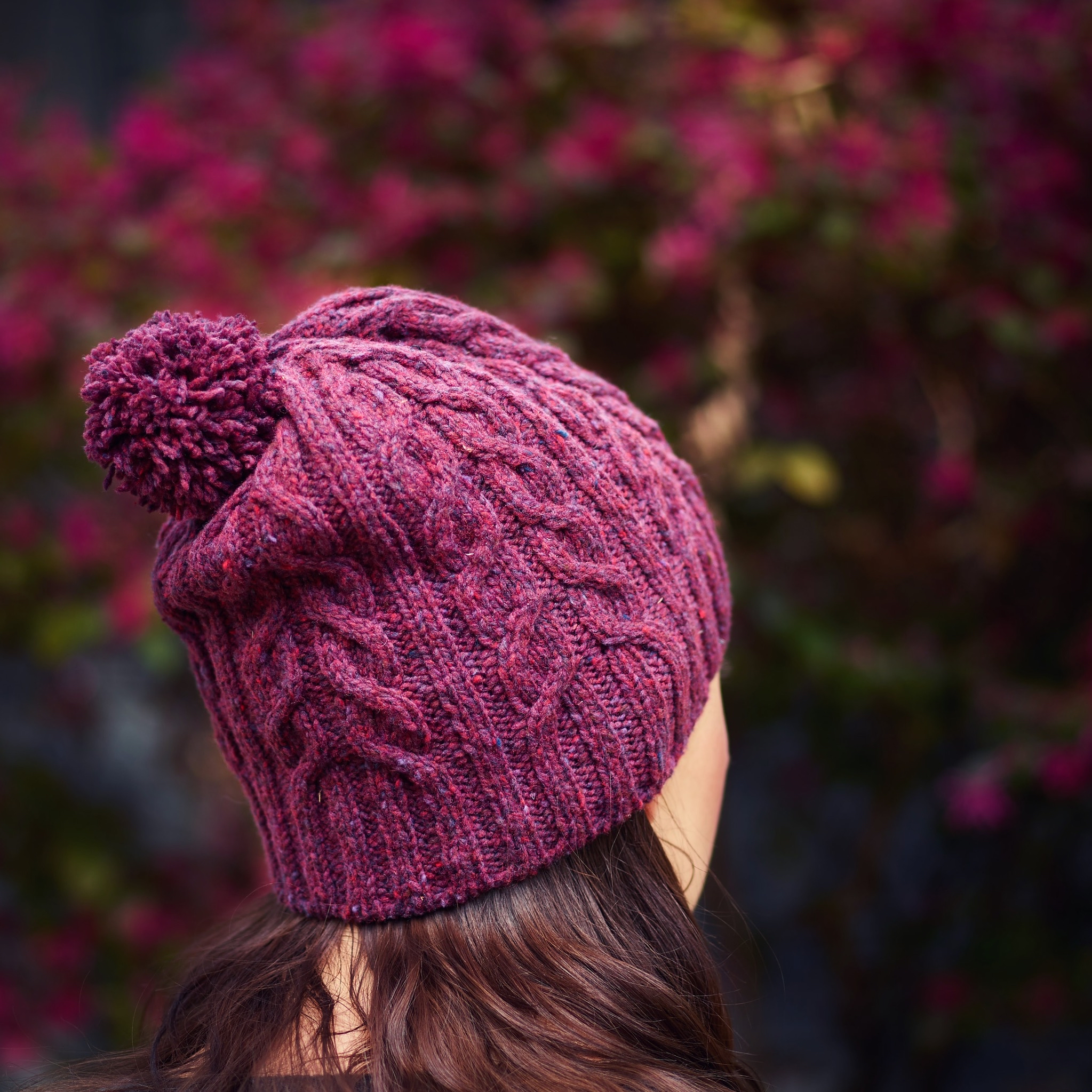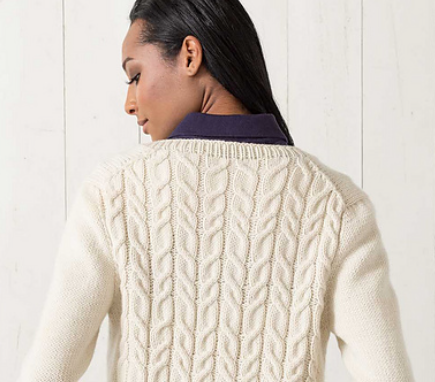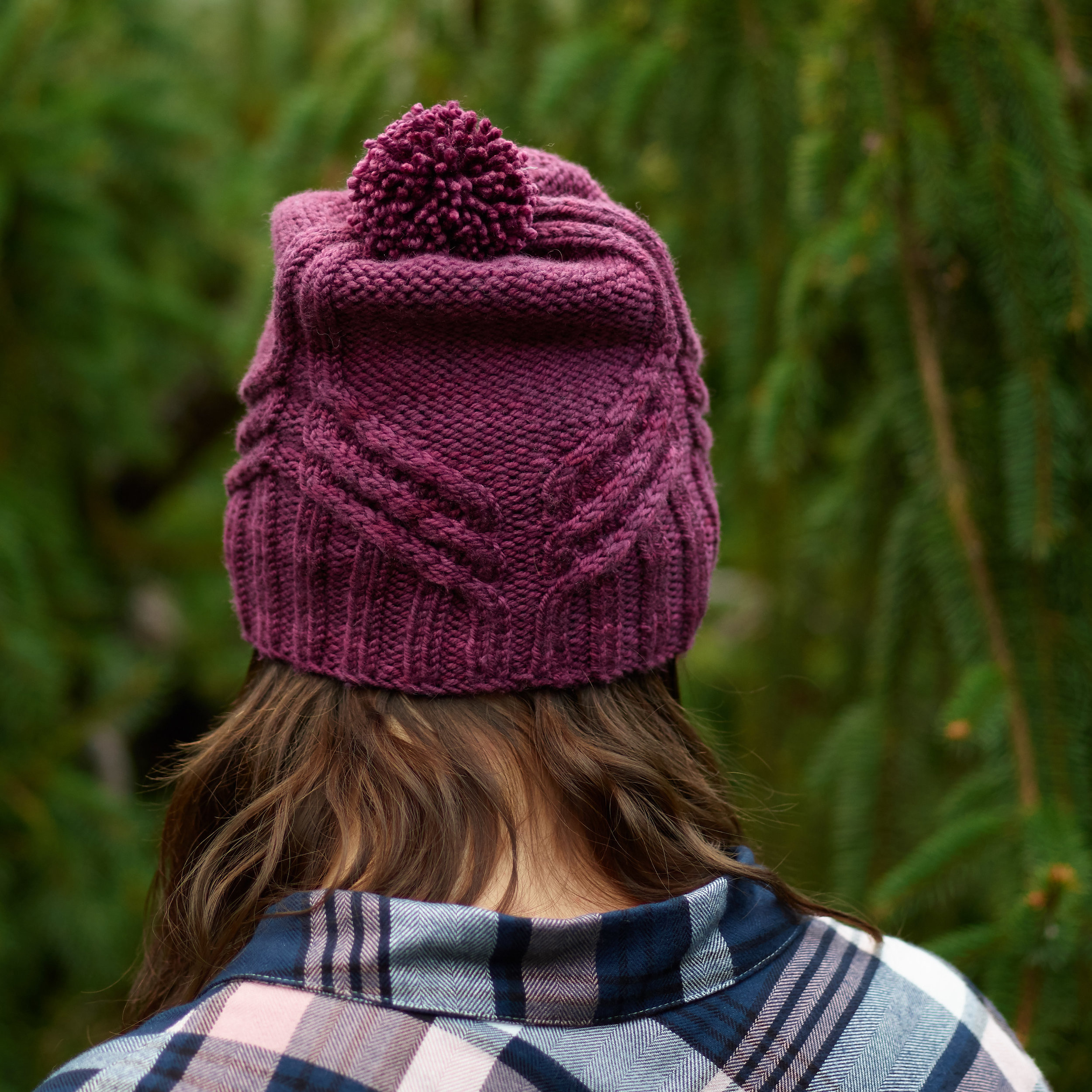Theory Thursday: Ply Counts and Cables
On Theory Thursdays, I’ll be tackling (in brief) a question about design theory/overall approach/yarn selection, etc. These aren’t really “technique” questions, in the sense of how to execute something in your knitting, but they’re questions to think about before you get started.
YOTH’s Big Sister’s multi-ply structure helps Howell Mountain’s cables “read” clearly from a distance.
Q: I read somewhere that you should use 2-ply yarns for lace, and 3- and 4-ply (or higher ply) yarns for cables. Is that true? Why?
So, as usual, there’s a long and a short answer to this question. The first answer is: no! Of course not. You, fearless knitter, should use whatever yarn you like for whatever you want to use it for. The second answer, like so many things in knitting, is, “sort of.”
The origin of the “ply rule” is this (approximately): a strand of yarn is made up of plies. A given strand of yarn may have almost any number of “plies” (strands of spun fiber that are lighter in weight and smaller in diameter than the final yarn), but for the most part, between one and twelve. Usually these plies are twisted together in one of the final steps in yarn production, and typically the plies are twisted in the same direction as the individual plies are spun (there are more exotic production methods than this, but we’ll cover those on another day).
Plies provide structure. If you’ve ever knit with a single ply yarn, like Malabrigo Worsted, or Madelinetosh Merino Light, or Brooklyn Tweed’s Quarry, or Quince’s Puffin, you know they don’t have much structure. Lots of softness, lots of drape, lots of flexibility, but not a lot of heft or dimensionality. Adding plies adds structure and energy to the yarn, and helps it hold together. Move to a two-ply yarn and it’s still somewhat vulnerable, but it breaks less, and it has a little more resistance when you go to pull it out of a center pull ball. Your stitches stand a little prouder and are easier to “read” in your knitting. Move to a three-ply, and suddenly the yarn feels round instead of ovoid, and your stitches are clearer and more defined still. The effect continues as the ply count increases, particularly if you use a yarn with a lot of twist. Ever knit with Magpie’s Domestic Worsted? It’s a 4 ply yarn spun super tightly, and it basically jumps out of the ball when you go to knit with it. It also produces cables that are approximately 8 miles high off the background fabric (that’s a scientific measurement, I promise). These two things are linked.
Two-ply yarns, which are more oval than round, tend to flatten out when you block them, and the stitches tend to roll away from each other. This makes them wonderful for lace, where you’re trying to get big open holes where your yarn-overs were that are easy to read, and for times when you want the overall texture of your knitting to kind of blur (this is doubly true of tweedy two-plies, like Harrisville’s Flywheel and Watershed). Three- and four- (and more!) ply yarns have the opposite effect: the round structure of the yarn tends to make the stitches lean into each other. This is lousy for lace, as it tends to make your yarn over “holes” shrink, making your lace pattern harder to read, particularly from a distance.
For cables, the effect runs the other way. Two-ply yarns tend to flatten out, taking your glorious, fluffy, three-dimensional cables with them. Three-ply yarns stay upright and round, helping your cables stand well proud of the background fabric. Thus, the general wisdom is that you should use single-ply and two-ply yarns for lace projects, and multi-ply yarns for projects with cables (or bold gansey textures, even, where you want to be able to see excellent stitch definition from a mile away).
So, is that general rule of thumb true? Yes (and not just because it is the approach found in Clara Parkes’ classic The Knitter’s Book of Yarn, which is a book that you should read). There’s a reason traditional Arans and Ganseys are made out of four-ply yarns, and this is it, or at least one version of it. Typecasting sometimes works.
If the effect you want is dramatic, holey lace and high-definition, three-dimensional cables, this conventional wisdom works, and is worth following. And sometimes, you absolutely want that! For example, I will pretty much never say no to a hat with mile-high cables on it that scream “LOOK AT ALL THE KNITTING I WAS KNITTING!” from halfway across the Dutchess County Fairgrounds, and I think you probably shouldn’t either (really—that is a hat that you need in life). Sometimes it’s wisdom worth following because that structure has benefits beyond stitch definition, and the added cable height just comes along for the ride, like on a big cabled cardigan that you want to wear like outerwear.
Sometimes all that height isn’t that exciting, though. Sometimes you want the cables to blur into a kind of overall texture, and you’re not going for a particular graphic impact. Sometimes you want a finished object that feels lighter and airier, which a less-structured yarn may tend to provide, like if you’re making a gigantic shawl. And sometimes you really, really, really don’t want your fabric to be super thickly laden with cables because of where it has to go on your body. This is particularly true with pullovers, because, well, I’m not sure if you’ve noticed, but they tend to cover the front of your body, which, at least for many people I know, is not a place where they think, “gosh, what I really need is adding a ton of visual and physical bulk right here.” In these kinds of projects, casting “against type,” and using a single-ply or two-ply yarn, even in a cabled design, can give you the texture you’re looking for, without the height or bulk you don’t want.
A few examples: Wildwood Trail (top left) and Great Island (top right) have very similar cable patterns, but one was knit in Brooklyn Tweed’s Shelter, a woolen-spun two-ply that produces quite flat cables, and the other in Woolfolk TOV, an eight-ply, cable-spun yarn with incredible stitch definition. My Yountville Slouch hat, in Sincere Sheep’s Cormo Worsted, and Shasta hat, in Miss Babs’ Madison, take advantage of tight twist and multi-ply structure to add cable height and dimensionality.
There are still a few more things to think about and ways to either work around or lean into these properties as you pair yarns and projects, which we’ll explore in future weeks, but these are a few core principles to keep in mind.
What are your favorite yarns for cables? Do they tend to vary by type of project?




